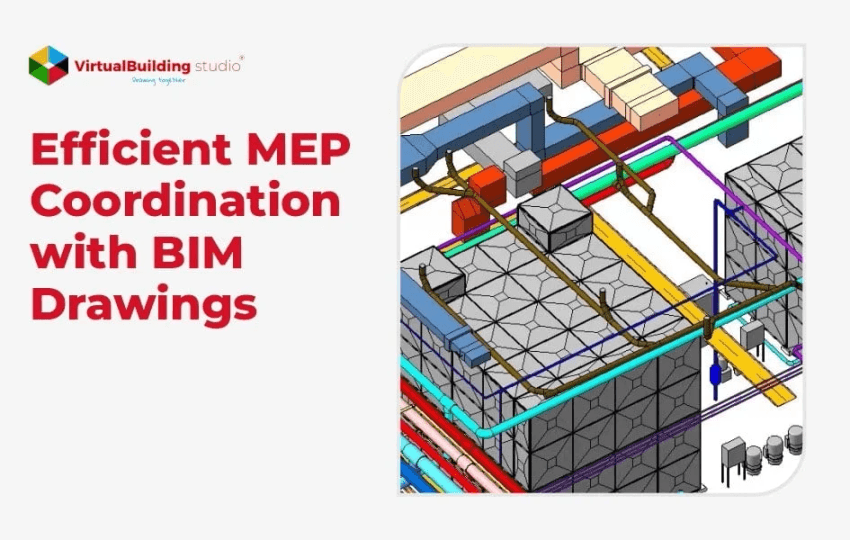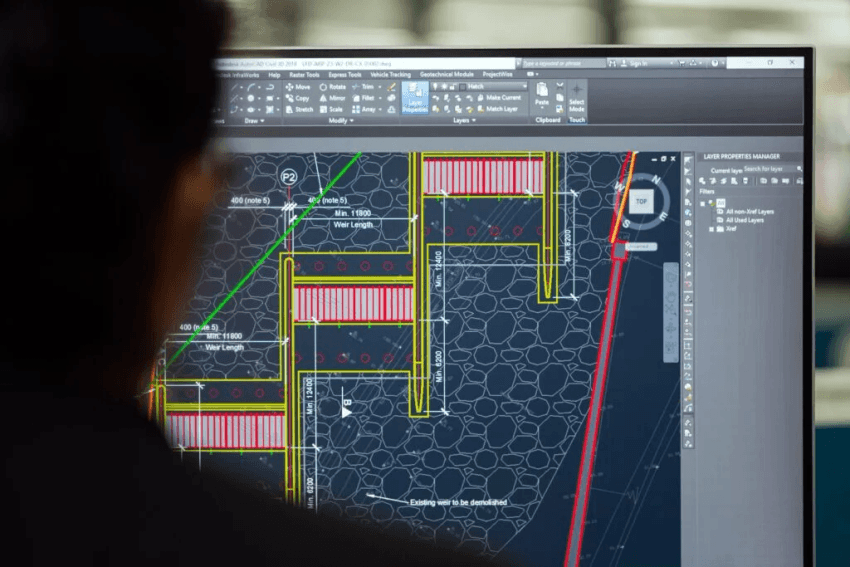
Each structure started with a pencil and a sheet of paper not long ago just a few decades back. Architects created huge structures by sketching on rolls of paper taped together to form a canvas that stretched hundreds of feet across.
Architects would lie on top of them, meticulously drawing out the building’s form. A change in the position of the restroom, the count of steps, or a small inclination mistake could result in the overall process being restarted.
The Architecture, Engineering, and Construction industry are currently through another transformation. As the supremacy of modern technology rises, it is becoming increasingly obvious that the sectors will never be the same.
BIM is the latest methodology being adopted in the design and construction industry. The convenient 3D model offers BIM MEP coordination for a time-efficient and budget-friendly process with a minimized scope of errors.
MEP modeling has enabled architects to test numerous options for each discipline before fixing the final one. Whether it’s a small cubicle or a huge shopping mall, BIM drawings represent the functional and aesthetic design elements of a building. MEP coordination within these structures makes the process easier and more efficient.
Traditional CAD Drawings vs MEP 3D BIM Modeling
The conventional approach towards planning and designing has its own set of pros and cons. However, it has faced a lot of challenges in terms of MEP coordination. A few of these include:
- No clash identification in the planning stage due to the lacking visualization and collaboration of services.
- Reworks and re-designing due to internal errors and poor coordination.
- Delay in the construction schedule and hiked costs.
- Poorly coordinated design due to the CAD approach.
The introduction of BIM in the coordination services offers 3D visualization with the MEP modeling which fosters communication and coordination amongst the design and services teams.
MEP modeling creates harmony among the services to lay a strong foundation for the construction.
Introduction to BIM Technology
Designers may use BIM to generate virtual 3D models. More importantly, unlike former modeling methods, BIM is a virtual representation of both a building’s functional and physical features.

Including everything from the geographic information to manufacturing requirements, amount of light space will get to the project’s overall environmental effect, anything and everything may be mapped using a BIM model. BIM not only depicts how a structure will seem but also how it will function.
BIM allows collaborative working on one model in the cloud. After an architect conceptualizes and designs a building, builders construct it using the same model; after the building is completed, the owners use BIM to plan maintenance and make infrastructure improvements.
BIM creates scheduling and logistics automatically at each stage of the project’s life cycle, reducing mistakes, improving cost forecasts, and expediting completion.
The Role of BIM Drawings in MEP Coordination
BIM drawings play a central role in achieving precise and clash-free MEP BIM Coordination across all building systems. Unlike traditional 2D plans, BIM drawings are data-rich, 3D-coordinated models that integrate architectural, structural, and MEP components within a unified environment.
At the core, these intelligent models are built using advanced 3D BIM Modeling techniques and platforms like Revit, enabling highly detailed representation of mechanical, electrical, and plumbing systems. This digital environment fosters seamless MEP BIM Services by allowing teams to visualize, analyze, and coordinate components in real-time.
Key advantages include:
- Clash-free Documentation: Automated clash detection within the model ensures conflicts between systems are identified early before they impact construction.
- Multi-disciplinary Integration: All trades operate within a shared model space, streamlining coordination and reducing fragmented communication.
- Real-time Updates & Version Control: BIM platforms ensure that every stakeholder accesses the most current drawing version, avoiding costly errors caused by outdated documentation.
With Revit BIM Modeling Services, BIM drawings evolve into collaborative, error-resistant tools that significantly improve decision-making, reduce field conflicts, and elevate the quality of MEP installations.
BIM and MEP Collaboration – A Crucial Linkup
Typical MEP design begins in the latter phases of the project lifecycle, but BIM-led MEP coordinating begins in the initial phases. In the production and implementation of MEP drawings, BIM has shown to make a critical difference.
Drawing and detailing become considerably more exact, detailed, and dependable when using a BIM-based methodology. BIM MEP coordination designs have extremely high accuracy of information.
Allied domains such as architecture, structural, and MEP incorporate 3D BIM models. These models give accurate and reliable documentation once they’ve been harmonized and made clash-free.
The physical assembly of different MEP and fire protection systems is made rapid and smooth owing to clash-free MEP modeling. As the collaboration offers access to one model to various professionals, informed and proactive decision-making can be facilitated to make the on-site construction obstructions-free.
BIM MEP coordination may accelerate the building process with versatility, scalability, rapid turnarounds, and fewer overhead expenses. Another notable feature of the system is that it can be utilized concurrently by architects, engineers, and builders; any modification given by one person has immediately reflected the others, allowing for real-time cooperation and communication.
Unlike other systems that are only utilized when a structure is being planned and built, BIM is used throughout the life cycle of a building, from conceptualization through destruction, renovation.
The Need for MEP BIM Coordination
MEP coordination is a complicated and challenging process due to the design, relations, and spatial issues involved with the three different disciplines. Without details of these systems, the probability for construction errors can hike which may result in delayed construction with extra cost.

MEP modeling with the latest software technology ensures that a project is error-free. MEP coordination can identify the conflicts and these can be resolved before the on-site construction begins.
BIM MEP coordination paves a smooth path for the builders to complete the construction as per the fixed schedule and costs. The advantages offered by MEP coordination are:
Efficient schedule, installation, and design
Because MEP designs are coordinated across mechanical, electrical, and plumbing divisions, they facilitate enhanced fabrication, placement, and scheduling in the construction process.
Contractors may use MEP modeling to construct exact HVAC, electrical, and plumbing systems based on a comprehensive set of blueprints. BIM MEP coordination offers a smooth onsite construction.
Reduced time of installation for the engineers and contractors
Engineers and builders may complete seamless installations using detailed outlines of configuration systems based on accurate measurements, connections, and components.
A great amount of time can be saved by installing MEP systems in consistent and dependable locations specified on MEP models.
Uniform sizes and modules
MEP designs that are synchronized enhance consistency and building performance by allowing MEP systems to be standardized.
Precise cost estimation
Builders may easily get product and material pricing with MEP coordination drawings. This aids in the streamlining of the supply chain, the reduction of material waste, the reduction of building expenses, and the improvement of planning activities.
Benefits of Using BIM for MEP Coordination Services
Adopting BIM for MEP coordination offers a structured, data-rich, and visual approach that significantly reduces construction risks. By integrating MEP BIM Services early in the project lifecycle, stakeholders gain better control over design accuracy, material usage, and on-site execution.
Here’s how MEP BIM Coordination makes a difference:
Clash Detection and Resolution Before Construction
One of the most critical benefits of 3D BIM Modeling is the ability to detect and resolve clashes before reaching the construction site.
- Software tools like Revit and Navisworks facilitate coordination among MEP, architectural, and structural systems.
- Hard and soft clash detection helps identify conflicts between ducts, pipes, conduits, and beams in the design phase.
- This reduces rework, change orders, and delays during construction.
Improved Collaboration Among Stakeholders
MEP BIM Coordination ensures that all project participants work from a single source of truth.
- Shared BIM models enhance visibility for architects, engineers, contractors, and fabricators.
- Cloud-based platforms enable real-time updates and communication across disciplines.
- Transparency boosts accountability and minimizes miscommunication or design discrepancies.
Accurate Quantity Take-offs and Prefab Planning
With data-rich Revit BIM Modeling Services, material estimation becomes more precise.
- MEP models enable automated quantity take-offs, reducing manual errors.
- Accurate component placement supports prefabrication and modular construction strategies.
- This not only accelerates the build but also cuts down on material waste.
Time and Cost Savings
By addressing issues virtually, MEP BIM Services help mitigate costly surprises.
- Significant reduction in RFIs, design conflicts, and field coordination delays.
- Early clash resolution minimizes site work interruptions.
- Overall project timelines shrink, leading to financial and schedule efficiencies.
Enhanced Site Execution
Well-coordinated 3D BIM Modeling results in clearer construction documentation.
- Installers and site teams benefit from visual guidance and well-defined layouts.
- Reduced ambiguity lowers the risk of errors during the installation of HVAC, electrical, and plumbing systems.
- Ensures better alignment with project specifications and construction sequences.
By investing in robust MEP BIM Coordination, project stakeholders can unlock higher productivity, fewer change orders, and greater certainty throughout the construction lifecycle.
Utilizing Automation and Innovation in MEP BIM Services
With the addition of automation technologies, BIM will be even more robust. Leveraging Dynamo, APIs, and other extensions to automate MEP layouts will assure onsite construction efficiency.
- As an information coordination tool across areas and components, dynamo-based parametric models can effectively coordinate spaces and develop family information.
- Mechanical loads can be calculated using computerized Revit MEP tools based on industrial regulations, and material supplies can be calculated using a quantity survey tool.
- Customized Revit plugins may be adopted to give more information to each MEP element in a methodical manner, ensuring that the output meets industry standards.
- Dynamo may be utilized to pick machinery capacity, cooling and heating loads, pipe size, and other parameters depending on room specifications.
Choosing the Right BIM Partner for MEP Coordination
Successful MEP BIM Coordination hinges not just on software but on the expertise of your BIM partner. Selecting the right team ensures that your design is not only clash-free but also construction-ready.
Here’s what to look for:
- Proven Experience in MEP BIM Services: Choose a BIM service provider with a track record in complex building systems with HVAC, electrical, and plumbing across various project scales.
- Expertise in Revit MEP Modeling: Mastery of Revit BIM Modeling Services ensures precise modeling, smart families, and native coordination workflows.
- Multi-disciplinary Integration Capability: Your partner should be adept at integrating 3D BIM Modeling across architectural, structural, and MEP trades, preventing scope gaps and misalignment.
- Commitment to Collaboration: Look for BIM consultants near you who participate proactively in coordination meetings, issue tracking, and model reviews.
With the right partner, BIM becomes a strategic tool that elevates MEP coordination from reactive to proactive, saving time, cost, and headaches.
MEP BIM Coordination - The Future of the Construction Industry
Relying on collaboration, efficiency, and performance analysis, BIM is increasingly being used in the AEC sector. For many organizations, this means making a quick switch from traditional 2D CAD to 3D BIM modeling to accomplish generative architecture.
BIM MEP coordination in the early phases of a project may make the design more productive and efficient for smooth on-site construction.
The technological possibilities are continuously expanding. As per the innovations and predictions for the future of the construction industry, builders will be using VR headsets to tour the building they’re creating digitally, opening doors, and going through corridors even before the first chunk of soil is dug up.
Conclusion
BIM drawings are essential for accurate and streamlined MEP BIM Coordination, offering a unified approach to integrating architectural, structural, and MEP systems. By leveraging 3D BIM Modeling and tools like Revit BIM Modeling Services, teams can detect clashes early, improve collaboration, and enhance documentation accuracy. The result? Fewer change orders, reduced delays, and more efficient project delivery.
For forward-thinking firms, investing in MEP BIM Services isn’t just a technical upgrade; it’s a strategic decision that drives cost-effectiveness, constructability, and long-term project success.
Ready to take control and unlock the full potential of BIM MEP coordination?




